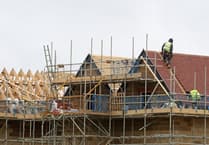THIS week, we look back around 100 years – to the time when a train steams over the arch at the top of Dawney Hill in Pirbright.
Gole Road is to the left of the arch. On the other side, the A324 becomes Connaught Road.
It is possible to suggest roughly when the photo was taken. In the foreground is an Automobile Association (AA) sign that says “Motorists slow down through tunnel”.
The AA was founded in 1905, and another of its signs can be seen at the opposite end of the arch.
Today, traffic lights control vehicle movement through the arch.
The steam locomotive gives a better idea of when the photo was taken. My good friend Geoff Burch, a retired railwayman with a wealth of knowledge of railway and locomotive history, has identified the loco as of the T14 class.
These locos were designed by Douglas Drummond, a chief mechanical engineer of the London & South Western Railway (LSWR).
Ten T14s were built between 1911-12 at the railway company’s works at Eastleigh in Hampshire.
They were used to haul express passenger trains between London Waterloo station and Southampton and Bournemouth.
As good as they were at the time, having some of the latest features in steam loco design, they were plagued by heavy coal and water consumption combined with serious mechanical problems – hot axle boxes on their wheels.
Another clue to the date of the photo is that on the loco’s tender, the blurred letters “LSWR” can just be seen.
On 1 January 1923, most of the numerous railway companies in Britain were amalgamated into four big businesses – the London, Midland & Scottish Railway, the London North Eastern Railway, the Great Western Railway and the Southern Railway.
The LSWR was taken over by the latter.
Liveries along with the names of the companies on the sides of locos and tenders were changed, but not necessarily straight away. Therefore this photo probably dates from about 1911-12 to about 1924-25, give or take a year or two.
The railway embankment that takes the line over the arch is spectacular. I wonder what the locals thought of it when it was being constructed as the line from London was extended towards Southampton after it had reached Woking in 1838.
The movement of thousands of tons of earth by the navvies must have been a sight to behold.
There is a local connection to Drummond, who died at his home in Surbiton on 8 November 1912. He was 72.
He had got cold and wet and took a hot bath for his numb feet. He was scalded by the boiling water, neglected his burns and gangrene set in. Amputation was necessary, but he refused an anaesthetic and died of the shock.
He is buried in Brookwood Cemetery, not far from the railway line where his steam locos once thundered by.
My thanks go to Geoff’s sister-in-law Patsy Burch (née Rice).
Other photos of Pirbright will be featured on future Peeps pages.
They were found years ago in a house named Burrow Hill in School Lane, Pirbright.
The house once belonged to Miss Eva Nethercliff. When she died, it passed into the ownership of the Rice family.
If you have memories or old pictures relating to the Woking area and its people which you would like to contribute to this column, call David Rose on 01483 838960, or write to the News & Mail.

.jpeg?width=209&height=140&crop=209:145,smart&quality=75)



Comments
This article has no comments yet. Be the first to leave a comment.